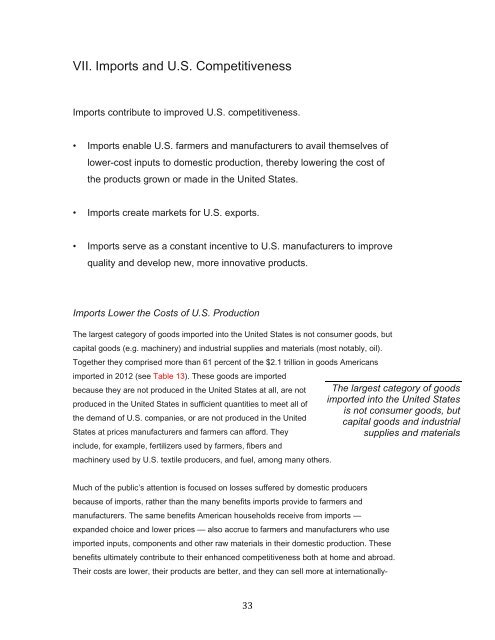Create successful ePaper yourself
Turn your PDF publications into a flip-book with our unique Google optimized e-Paper software.
VII. <strong>Imports</strong> and U.S. Competitiveness<br />
<strong>Imports</strong> contribute to improved U.S. competitiveness.<br />
• <strong>Imports</strong> enable U.S. farmers and manufacturers to avail themselves of<br />
lower-cost inputs to domestic production, thereby lowering the cost of<br />
the products grown or made in the United States.<br />
• <strong>Imports</strong> create markets for U.S. exports.<br />
• <strong>Imports</strong> serve as a constant incentive to U.S. manufacturers to improve<br />
quality and develop new, more innovative products.<br />
<strong>Imports</strong> Lower the Costs of U.S. Production<br />
The largest category of goods imported into the United States is not consumer goods, but<br />
capital goods (e.g. machinery) and industrial supplies and materials (most notably, oil).<br />
Together they comprised more than 61 percent of the $2.1 trillion in goods Americans<br />
imported in 2012 (see Table 13). These goods are imported<br />
because they are not produced in the United States at all, are not<br />
produced in the United States in sufficient quantities to meet all of<br />
the demand of U.S. companies, or are not produced in the United<br />
States at prices manufacturers and farmers can afford. They<br />
include, for example, fertilizers used by farmers, fibers and<br />
machinery used by U.S. textile producers, and fuel, among many others.<br />
Much of the public’s attention is focused on losses suffered by domestic producers<br />
because of imports, rather than the many benefits imports provide to farmers and<br />
manufacturers. The same benefits American households receive from imports —<br />
expanded choice and lower prices — also accrue to farmers and manufacturers who use<br />
imported inputs, components and other raw materials in their domestic production. These<br />
benefits ultimately contribute to their enhanced competitiveness both at home and abroad.<br />
Their costs are lower, their products are better, and they can sell more at internationally-<br />
The largest category of goods<br />
imported into the United States<br />
is not consumer goods, but<br />
capital goods and industrial<br />
supplies and materials


